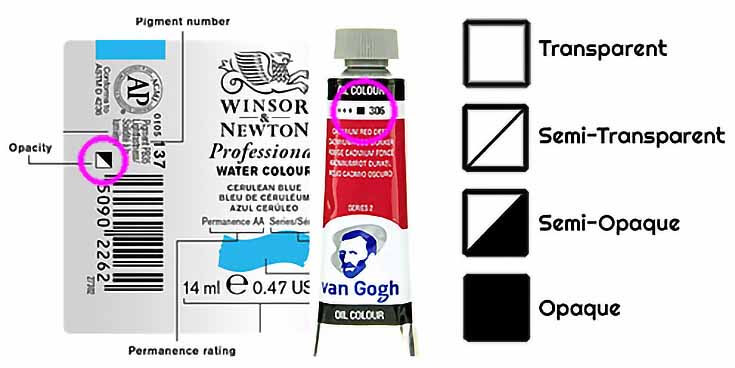Do you mix your own black oil paint, or use a black paint straight out of the tube?
It’s certainly more convenient to buy black paint in the tube, but there are some definite benefits to mixing your own—like the ability to shift the color temperature of your black paint to harmonize better with your piece.
Not to mention that if you choose transparent colors to mix your black, you’ll get an added depth to your black paint that will help it recede further on your canvas. (Transparent black can be used in glazing, too.)
So why do transparent black oil paints work better?
Opaque pigments reflect more light, so they appear lighter. Transparent colors (including black) will let more light penetrate into the paint and get dispersed, so they appear darker and richer.
Here are some tips for mixing the darkest, most transparent blacks:
1. Skip the Cadmiums
Cadmium colors are very opaque, so you will not get a truly transparent black if you include them your mix. Substitute Cadmium Red with Winsor & Newton Bright Red which has the same hue but is totally transparent. Alternatively, you can use Alizarin, Crimson Lake, or Magenta for your transparent red color.
NOTE: Mixing a true primary like Winsor & Newton Bright Red with Viridian will give you a good, deep black that works well with red-green harmonies.
2. Use Burnt Umber or Burnt Sienna with a dark blue
You’ll quickly notice that it’s hard to get an absolutely 100% dark black when you mix your own, because black technically requires all three primaries (or a secondary paired with its complimentary primary).
Adding that third primary (yellow) is typically where we often start to get away from the darkest of blacks, because most yellows will lighten a mix.
The best solution is to put Burnt Umber or Burnt Sienna as the “yellow” primary. Burnt Umber is more orange than yellow but since orange contains yellow and that “orange” is still very dark, it works well for that purpose.
That’s why you can get a very good black by mixing Burnt Umber with a dark blue like Ultramarine Blue, both of which are transparent. If you are using a different dark brown than Burnt Umber, check the label for its level of transparency.
Burnt Sienna is another great option if you want to mix a good black with just two colors. And the advantage of working with two complimentary colors to make black is that you can shift your black toward a warmer or cooler tone just by increasing one of the two colors.
To get close to a truly pure black, however, I suggest using three colors. In particular, I recommend one of the following mixes:
• Prussian Blue + Alizarin Crimson + Burnt Sienna
• Prussian Blue + Alizarin Crimson + Burnt Umber
3. Always check if your colors are transparent
Your tube will have an opacity symbol on it to help you know if the color is transparent or not. This photo explains some of the different levels of transparency for oil paints:
Of course, some colors are almost always transparent. Here’s a short list:
• Ultramarine Blue, Phthalo Blue, Prussian Blue
• Sap Green, Phthalo Green, Viridian, Green Earth (Terra Verte)
• Transparent Earth Yellow, Indian Yellow, Transparent Gold Ochre
• Burnt Umber, Burnt Sienna
• Quinacridone Reds & Magenta, Alizarin Crimson, Transparent Red Oxide (Rembrandt), Perylene Red, Permanent Rose, Magenta, Crimson Lake
• Quinacridone Violet, Ultramarine Violet, Dioxazine Purple, Purple Lake
NOTE: This list varies a bit between brands (which is why I said “almost always transparent.” This list also does not apply to “Hues” which are cheaper colors that use different pigments to approximate standard colors.
To sum up, there are many ways to mix black:
Here are your four options:
1. Using the three primaries
Red + Blue + Yellow
2. Using a primary and a secondary (and vice versa)
Yellow + Purple
Blue + Orange
Red + Green
3. Using a brown and a blue
Burnt Umber + Ultramarine Blue
4. Using a blue, a red, and a brown
Prussian Blue + Alizarin Crimson + Burnt Sienna
Prussian Blue + Alizarin Crimson + Burnt Umber
You’ll get the darkest blacks by using all transparent colors: either from a brown and a blue; or a brown, a blue, and a red.
And as I mentioned earlier, the best part of mixing your own black oil paint is that you can mix your black colors cooler or warmer as-needed. By shifting the temperature of your black paint to match the color temperature throughout your painting, you’ll achieve a level of refinement that is sure to enhance your final work.
Special thanks to Eric Vanasse for this post! To learn more, visit artzok.com.
This post may contain affiliate links.

